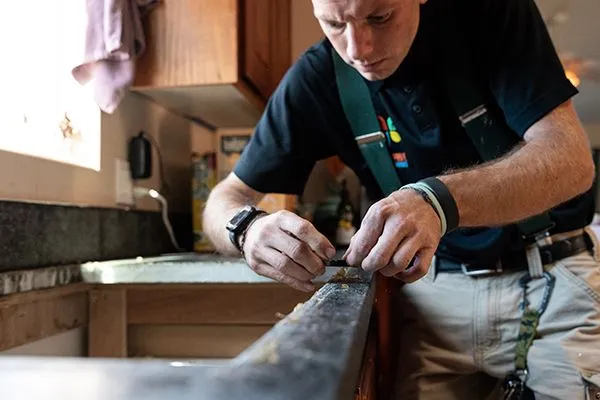
If you’ve been working as a tech for someone else’s business or doing HVAC work on the side, and now you’re looking to start a legitimate heating and air cooling business of your own, this guide is for you. We’ll cover everything from registering your business to ways you can automate your flourishing business with HVAC software.
Here you’ll find curated advice from successful HVAC business owners and industry experts. We’ll look at the legal and financial requirements, as well as how to market and sell your services.
How to start an HVAC business in 11 steps:
Step 1: Decide what HVAC services to offer.
What is your business going to specialize in? Think about your skills, experience, and expertise. Then research the demand for HVAC services and the competition in your area. Check out their reviews. That’ll give you a good idea of what customers want and need. What do they need only you can offer, or that you could offer better? It could be basic installs and repair, focusing on energy-efficient HVAC systems or smart home automation, or even more advanced services like geothermal heating and cooling. You may need additional HVAC tools or training based on the services offered. Make sure to compare services to how much you can profit from each.
Should you charge a diagnostic fee?
It takes time and money to drive to a customer’s home or office and diagnose the problem. This is true if they choose to get work done or not. It’s a standard practice for HVAC business owners to add a diagnostic fee to cover their expenses for the trip.
A bigger debate we’ve seen among HVAC Pros is whether to waive the diagnostics fee when the customer agrees on a repair. Some companies simply waive the fee, while others credit the diagnostics fee toward the total cost of the repair. Some don’t waive it at all. Another common option is to waive the fee for certain higher end jobs, like total system replacements.
There’s not one right way to charge, but here are some things to consider. If you waive the diagnostics fee, can you still make your goal revenue per service call? How can you balance valuing your company’s time and resources with building trust and rapport with your customers?
If you’re still feeling unsure about how to price your HVAC services, you can download our free HVAC price list template.
Case study – keeping a side job
Joel Nieman is the owner of AirAce Heating and Cooling. He started doing HVAC work on the side before he took the leap to running his business full-time. Pretty smart move. For a couple of years, he used the revenue from his part-time work to build up a better inventory of tools.
“If I put a system in, I just turned around, took that money and reinvested it. I’d buy a better pump or a better tool. I’d figure that tool into the price of the job so that next time I’d be equipped to do a better job,” Joel said.
Make money. Spend money. Makes sense.
Step 2: Get HVAC licensed and certified.
Time to get official. Learn the licensing requirements and regulations related to HVAC services in your city and state. If becoming certified means a combination of education and hands-on training, check out an HVAC program at a community college, vocational school, or trade school. Many licensing bodies also require a certain number of practical work experience hours before granting a license. Many HVAC companies and unions offer apprenticeships if you need more. When you’ve completed the required education and training, apply for the HVAC licensing exam to prove your knowledge in systems, installation, repair, and safety practices. The licensing board in your state will have exam details.
Step 3: Choose the right name for your HVAC business.
The right name is a big deal in creating a strong brand identity and attracting customers. Make sure it’s easy to remember and pronounce, professional, not too long, and reflects the essence and values of your HVAC business, whether residential or commercial. Consider including words like “heating,” “cooling,” or “air” in your name if you offer those services. Be descriptive. You can include words that speak to your location, like “coastal,’ or “citywide.” Check for availability and avoid legal problems! Ask for feedback from a number of sources. And finally, how will that name work with your logo and branding? You want them to work well together and stand out from the crowd. This name is a long-term commitment. Be creative and take your time!
Step 4: Meet with a bookkeeper or financial advisor.
A financial advisor can help you make informed money decisions. They can help you with details like how to secure startup capital, get loans or financing, managing cash flow, tax planning, and budgeting. Look for advisors who specialize in working with small businesses or have experience in the HVAC industry. Ask around for recommendations or search online directories. Check your potential advisors track record and client references. You want someone you can work well with. When you meet, take things like your business plan, goals, estimated startup costs, and projected revenues and expenses. They’ll explain their services and fees, whether it’s an hourly rate, a percentage of assets managed, or a fixed fee. Ensure you are comfortable with the terms before proceeding.
Step 5: Register your HVAC business.
After landing on a name, choose the legal structure for your business, like sole proprietorship, partnership, limited liability company (LLC), or corporation. Each one has different legal and financial implications, so consult with a business attorney or accountant to determine the best option.
Then register your business for taxes with the appropriate tax authorities. You may need an Employer Identification Number (EIN) from the Internal Revenue Service (IRS) if you plan to hire employees. You’ll also need to register your HVAC business with government agencies. Contact your local or state business registration office to learn about the specific forms and fees for your city/state.
Remember to create contracts and legal compliance docs for your business. Outline your terms and conditions for services provided, including pricing, warranties, and liability. We recommend consulting with a business attorney or accountant to help with all this.
Step 6: Create an HVAC business plan.
Outline your company’s goals, target market, services offered, marketing strategies, and key financial projections. This plan will serve as a roadmap and can be useful when seeking financing or partnerships. An HVAC business plan should evolve over time. Regularly review and update your plan as your business grows and market conditions change. Here’s what you need in your plan:
Step 7: Open a business bank account.
When picking a bank, look for banks that offer business banking services. Should be most of them Now consider factors like fees, account features, branch locations, online banking options, and customer reviews.
Banks will require specific documentation to open a business account. Have these ready:
Depending on the bank’s requirements, you may need to make an initial deposit to activate the account. Carefully read and understand the fees, limits, overdraft protection, terms and conditions, and online options associated with your business banking account.
Step 8: Get bonded and insured BEFORE you start the first job.
Research the specific bonding and insurance requirements for HVAC businesses in your location. Start with insurance. This typically includes general liability insurance to protect against property damage or injuries, workers’ compensation insurance if you have employees, and commercial vehicle insurance if you have company vehicles. An insurance agent who specializes in business insurance can help you there.
Then find a reputable bonding company that specializes in providing bonds for HVAC businesses. You can search online or ask for recommendations from other contractors or industry associations. Gather documents like proof of business ownership, financial statements, personal and business credit information, and any licenses or certifications required for HVAC contractors in your area. Once your application has been evaluated based on factors like your creditworthiness, business experience, and financial stability, you’ll be issued a bond, (a financial guarantee that you’ll fulfill your contractual obligations). When you have your surety bond and insurance policies, you may need to submit copies of these documents to government agencies or licensing boards that oversee HVAC contractors in your area.
Step 9: Take advantage of these 7 key marketing strategies.
How can you attract customers and stand out against the competition? Here are a few ways.
Marketing strategies should be monitored and adjusted based on performance. Analyze data, track leads, and measure the effectiveness of your marketing efforts. Then refine and start all over.
Additional resources:
Step 10: Hiring your first HVAC technicians.
This is a crazy step! And it’s so stupid important.
First determine the skills and experience you’re looking for in an HVAC technician. This may include knowledge of HVAC systems, certifications, licenses, and experience with installations, repairs, and maintenance. Advertise on job boards online, on social media, and industry websites. Create an HVAC job listing for many of the popular websites and forums.
When you start receiving applications, carefully review each one to identify candidates who meet your needs. Shortlist the most promising candidates, verify licenses, and schedule interviews. Prepare a set of questions to check their technical knowledge, problem-solving skills, customer service abilities, and their fit with your company’s culture. (Speaking of that, make sure your culture promotes growth, teamwork, and communication.) Are they friendly? That can go a long way with customers. Do they have a team mindset? Don’t be afraid to reach out to references and former companies!
Make sure to offer a competitive salary and benefits package. You get what you pay for, and you want to keep those A+ team members. Offer ongoing training and support. Help them stay updated on industry trends, enhance their skills, and improve their overall performance.
Additional resources:
Where and when to find HVAC technicians
One of the biggest issues HVAC companies face is hiring and keeping good employees. Many businesses can’t guarantee full-time hours all year thanks to slow seasons. Others lose technicians to competing companies who can afford higher pay or better benefits. Here are a few tips to avoid these issues.
Step 11: Trust the best HVAC software to grow your business.
There are several HVAC software solutions available out there that can help streamline operations, improve efficiency, and enhance customer service. That being said, one has a 4.5 star rating and has become the trusted software choice for more than 30,000 businesses.
Housecall Pro is an all-in-one management software that simplifies scheduling, dispatching, job management, invoicing, payment processing, and customer communication. It also provides integration with QuickBooks and others. It’s the only HVAC management software you’ll ever need.
Explore the free demos, read user reviews, and consult with industry peers to make an informed decision.






